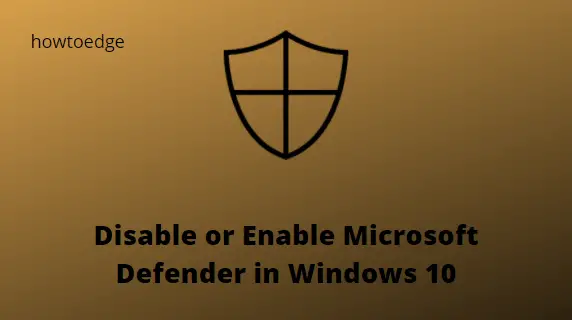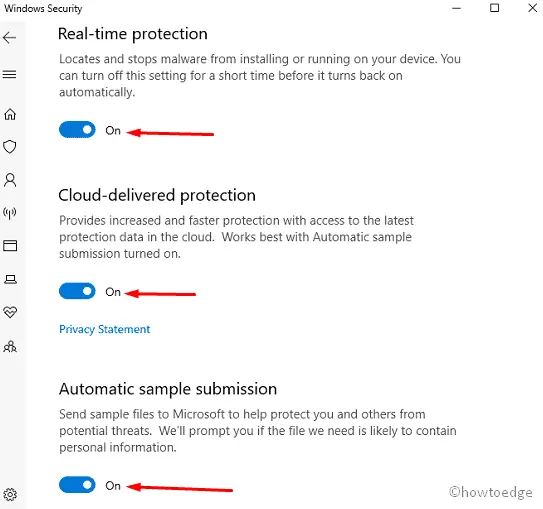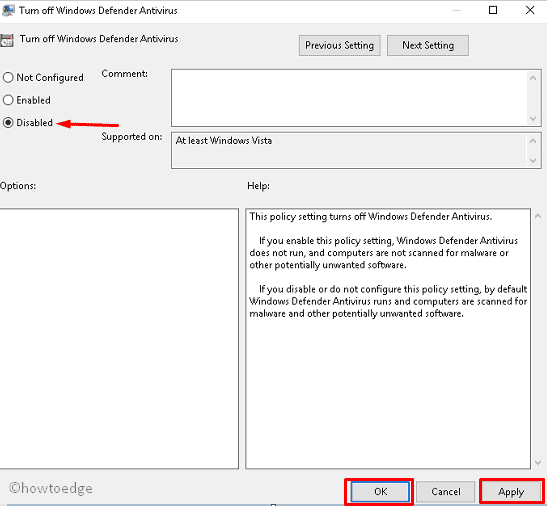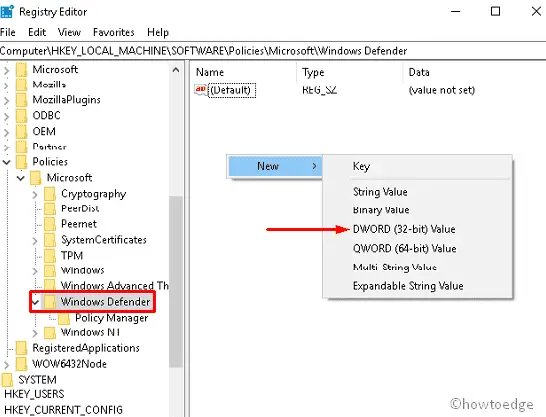The default antivirus software from Microsoft is Defender Antivirus. This application protects against unwanted viruses and malware on your computers. Although this software is one of the most popular antivirus solutions for computers, you may need to disable the protection from time to time. In this post, we will cover three different ways to disable Microsoft Defender Antivirus on Windows 11/10 PCs.

How to Disable or Enable Windows Defender in Windows 11/10
Do you want to disable the Windows Defender (in-built application of Windows) on your System? If yes, you can do the same in three different ways described in this article. Windows Security plays a vital role in protecting your PC from a suspicious attack similar to that of Kaspersky and Norton.
There are some advanced features in these programs that it lacks such as web monitoring, blocking new installation of software, etc. Windows Defender even occupies more space as compared to the aforementioned apps. These are the reasons why several users disable Windows Defender on their System. The three different methods are using local Settings, Registry Editor, and Local Group Policy Editor.
Recommended: How to Update Windows Defender antivirus program.
1. Through the System Settings
You can disable Windows Defender using the local Settings app. This is an easy process without any complexity. To do this, you need to follow these steps-
- Press the Windows+R keys to open the Run dialog box.
- Type windowsdefender: in the text box and press Enter.
- Next, select the Virus & threat protection category.
- Under the Virus and Threat Protection settings section, click on the Manage link.
- Now disable the following toggle switches (see snapshot as well).
- Real-time Protection
- Cloud-Delivered protection
- Automatic Sample Submission

- A new pop-up window will appear asking you to approve access. Click Yes to proceed.
This will temporarily disable Windows Security on your Windows 10 PC. Although this is the easiest way, it also has its drawbacks. The Windows Defender gets enabled by default when you next log in. This implies that when you Restart your system, the Settings switch back to its normal condition.
2. Disable or Enable Windows Defender using Local Group Policy
Alternatively, you can perform the same task using Group Policy. All you have to do is to follow these steps-
- Right-click on Start and click the Run option.
- Type
gpedit.mscin the void box and tap the OK button. - In the Group Policy Editor window, navigate to the following path-
Computer Configuration > Administrative Templates > Windows Components > Windows Defender Antivirus
- Double-click on Turn off Windows Defender Antivirus services (see snapshot below).

- Check the Disable checkbox to enable Windows Defender.
- Click the Apply > OK button to confirm the changes.

If you want to enable Windows Defender, follow the above procedure and check the Enable radio button.
Note: The Group Policy Editor only works in Windows 10 Pro and Enterprise versions. So, Windows 10 Home users cannot avail of this feature.
3. Disable or Enable Windows Defender Using Registry Tweak
Since Windows Defender is Microsoft’s in-built application, it doesn’t provide the features to Uninstall it. However, you can disable this tool either temporarily or permanently using registry tweaks. Here is how to proceed-
- Press Win & R altogether to launch the Run dialog.
- In the void box, type regedit and hit the OK button to launch the Registry Editor window.
- If the UAC prompt appears up, tap Yes to permit access.
- Now copy and paste the following path in the address bar then hit Enter to access the path:
HKEY_LOCAL_MACHINE\SOFTWARE\Policies\Microsoft\Windows Defender
- Go to the right pane and right-click on the blank area.
- Select New > DWORD(32-bit) from the context menu.

- Name the newly created key DisableAntiSpyware.
- After that double click on it and change its value to 1 from 0.
- At last, click OK to save the changes and Restart your system.
It will disable the Windows Defender on your desktop or Task Manager.
Note: Bear in mind, that any wrongdoings in the Registry might be risky for your system. It may corrupt your entire OS or personal files. This is why it is recommended to create a System Restore point to protect against the unwanted loss of data.
How to Enable Windows Defender in Windows 10
If you want to enable this app again, you have to go through the below procedure-
- Open Registry Editor and navigate to the following address.
HKEY_LOCAL_MACHINE\SOFTWARE\Policies\Microsoft\Windows Defender
- Move to its corresponding right pane and right-click on the recently created DWORD entry.
- Select Delete from the context menu.
- Once finished, close the Registry Editor and Reboot your system.
The Windows Defender icon and its settings will re-appear the next time you log in to your System.
Can’t enable Windows Defender antivirus Windows 10?
Listed below are a few suggestions that should help you if Windows Defender cannot be started:
- Check Windows Update.
- Ensure that you do not have any other security software installed.
- Confirm that the time and date are correct.
- Perform an antivirus scan on your computer.
- Make sure your internet zone is set up correctly.
- Review your Group Policy settings.
- Make sure your Internet service is up and running.
Conclusion
Windows Defender is the best tool to protect your system from any malware attack. However, sometimes it may prevent new applications from installing. If that’s the case, you can temporarily disable this app. In case, you want to install some other anti-malware program; you should permanently disable this application using either the 2nd or 3rd method. When you try to invoke some other security program on the system, Windows Defender will automatically disable Real-Time protection.




